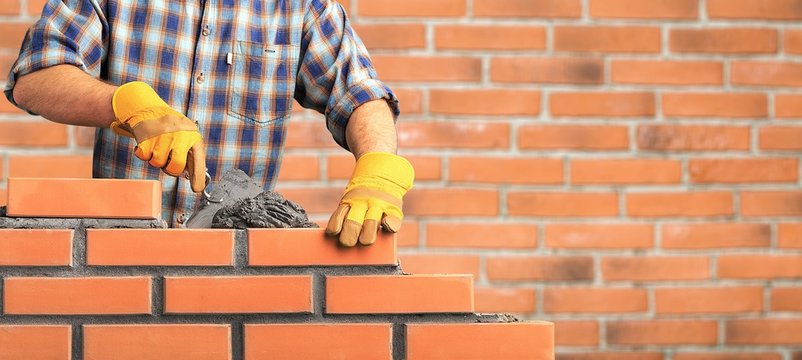Getting My Bricklayer Auckland To Work
Wiki Article
Bricklayer Auckland for Beginners
Table of ContentsThe Single Strategy To Use For Bricklayer Auckland7 Easy Facts About Bricklayer Auckland DescribedThe 5-Minute Rule for Bricklayer AucklandExcitement About Bricklayer AucklandThe Basic Principles Of Bricklayer Auckland Indicators on Bricklayer Auckland You Need To Know
Blocks must always be piled on planks; never stack them straight on unequal or soft ground. Do not store blocks on scaffolds or paths.Except where stacked in sheds, block stacks should never be greater than 7 feet high. When a stack of brick reaches an elevation of 4 feet, it needs to be tapered back 1 inch in every foot of elevation above the 4-foot level. The tops of block piles have to be maintained level, and the taper must be kept during unpiling procedures.
Structural bond refers to how the private masonry units interlock or tie together right into a single structural device. Using grout to stick nearby wythes of masonry.
Some Known Incorrect Statements About Bricklayer Auckland
Pattern bond refers to the pattern formed by the masonry systems as well as mortar joints on the face of a wall surface (Bricklayer Auckland). The pattern may arise from the architectural bond, or it may be simply ornamental and unconnected to the structural bond. Figure 4-4 reveals the 6 standard pattern bonds in usual usage today.The running bond is the simplest of the 6 patterns, consisting of all stretchers. Because the bond has no headers, metal ties usually create the structural bond. The running bond is used greatly in cavity wall surface building and construction, block veneer wall surfaces, and facing ceramic tile wall surfaces made with additional broad stretcher tile.
Excellent bricks must not degenerate when placed in water. Just when fat lime or clay mortar is used or when one is compelled to utilize blocks that are not well scorched, this soaking rule has to be relaxed.
See This Report about Bricklayer Auckland
In all situations, blocks ought to not be taken care of in baskets or in any type of other mode which will ruin the intensity of their edges. A layer of mortar is spread to cover the full size of the wall surface for an appropriate length of the lower training course.
Lastly, we push the side bulging mortar in strongly to be degree with the face of the wall surface if it is to be left unplastered. In the usual practice taken on by numerous masons, a row of bricks is first put on a thin layer of bed mortar leaving the cross joints empty.


The wall surfaces are raised truly plumb. All courses are laid truly straight as well as all upright joints really vertical.
See This Report about Bricklayer Auckland
For this objective, a wood straight side with college graduation giving a thickness of each block program consisting of joint can be made use of for guidance. For a thick wall surface, the above operation is repeated in addition to both faces of the wall surface as well as the interior loading blocks for the thick wall are stocked a comparable manner.
This procedure of loading open joints is described flushing-up. It is incorrectly left out for numerous training courses on some badly-executed tasks as well as only done later on (not after every training course) in an ineffective way. It is not a good method and needs to be prevented as it is crucial that every program must be purged up to the level if excellent work is required.

A Biased View of Bricklayer Auckland
The mortar increasing and filling up the vertical joints entirely and forms an exceptionally strong and strong wall surface. This is understood as larrying. see here For a rat trap bond work (as in the building of tooth cavity walls), if the mortar is placed carelessly on the block, a few of it will certainly fall under the tooth cavities and will certainly be wasted.The face of the brickwork will also be cleaned up of all mortar droppings, etc(ii) When scenarios render it essential to continue a portion of a structure in uneven programs, the job shall be constructed back (according to the bond used on the job) at an angle not steeper than 45 degrees so as to guarantee an attire and also efficient bonding.
Or else, for faces to be plastered, completing of the face joints need to be executed as discussed in below (This is really crucial.)(iv) The walls must be uniformly increased all around not leaving any type of component one metre (3 feet) less than look at here the other - Bricklayer Auckland. A day's job must not be greater than 1.
The 20-Second Trick For Bricklayer Auckland
When the facework is to be later plastered or the joints alone are to be sharp, the joints need to be raked while the wall is being constructed. Bricklayer Auckland. It must be raked to a minimal deepness of 12 mm by a raking device throughout the development of the job itself, when the mortar is still eco-friendly.
If smudging or aiming is not envisaged, the joints should be struck flush as well as finished at the time of laying itself, as currently stated. Half-brick walls check out here often tend to fracture unless treatment is taken in its building and construction. Brickwork in half-brick masonry is to be performed with stretchers in 1: 5 mortar.
Report this wiki page